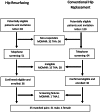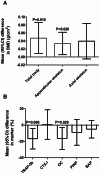Metal-on-metal hip prostheses and systemic health: a cross-sectional association study 8 years after implantation
- PMID: 23762480
- PMCID: PMC3677913
- DOI: 10.1371/journal.pone.0066186
Metal-on-metal hip prostheses and systemic health: a cross-sectional association study 8 years after implantation
Abstract
There is public concern over the long term systemic health effects of metal released from hip replacement prostheses that use large-diameter metal-on-metal bearings. However, to date there has been no systematic study to determine which organs may be at risk, or the magnitude of any effect. We undertook a detailed cross-sectional health screen at a mean of 8 years after surgery in 35 asymptomatic patients who had previously received a metal-on-metal hip resurfacing (MoMHR) versus 35 individually age and sex matched asymptomatic patients who had received a conventional hip replacement. Total body bone mineral density was 5% higher (mean difference 0.05 g/cm², P = 0.02) and bone turnover was 14% lower (TRAP 5b, mean difference -0.56IU/L, P = 0.006; osteocalcin, mean difference -3.08 ng/mL, P = 0.03) in the hip resurfacing versus conventional hip replacement group. Cardiac ejection fraction was 7% lower (mean absolute difference -5%, P = 0.04) and left ventricular end-diastolic diameter was 6% larger (mean difference 2.7 mm, P = 0.007) in the hip resurfacing group versus those patients who received a conventional hip replacement. The urinary fractional excretion of metal was low (cobalt 5%, chromium 1.5%) in patients with MoMHR, but creatinine clearance was normal. Diuretic prescription was associated with a 40% increase in the fractional excretion of chromium (mean difference 0.5%, P = 0.03). There was no evidence of difference in neuropsychological, renal tubular, hepatic or endocrine function between groups (P>0.05). Our findings of differences in bone and cardiac function between patient groups suggest that chronic exposure to low elevated metal concentrations in patients with well-functioning MoMHR prostheses may have systemic effects. Long-term epidemiological studies in patients with well-functioning metal on metal hip prostheses should include musculoskeletal and cardiac endpoints to quantitate the risk of clinical disease.
Conflict of interest statement
Figures



Similar articles
-
Two-year serum metal ion levels in minimally invasive total conservative hip resurfacing: preliminary results of a prospective study.ANZ J Surg. 2015 Mar;85(3):164-8. doi: 10.1111/ans.12868. Epub 2014 Oct 7. ANZ J Surg. 2015. PMID: 25288230 Clinical Trial.
-
One-year prospective comparative study of three large-diameter metal-on-metal total hip prostheses: serum metal ion levels and clinical outcomes.Orthop Traumatol Surg Res. 2012 May;98(3):265-74. doi: 10.1016/j.otsr.2011.11.009. Epub 2012 Apr 4. Orthop Traumatol Surg Res. 2012. PMID: 22480865
-
Metal ion levels and functional results following resurfacing hip arthroplasty versus conventional small-diameter metal-on-metal total hip arthroplasty; a 3 to 5year follow-up of a randomized controlled trial.J Arthroplasty. 2015 Jan;30(1):61-7. doi: 10.1016/j.arth.2014.07.036. Epub 2014 Aug 7. J Arthroplasty. 2015. PMID: 25172584 Clinical Trial.
-
Systemic toxicity related to metal hip prostheses.Clin Toxicol (Phila). 2014 Sep-Oct;52(8):837-47. doi: 10.3109/15563650.2014.944977. Epub 2014 Aug 16. Clin Toxicol (Phila). 2014. PMID: 25132471 Review.
-
European multidisciplinary consensus statement on the use and monitoring of metal-on-metal bearings for total hip replacement and hip resurfacing.Orthop Traumatol Surg Res. 2013 May;99(3):263-71. doi: 10.1016/j.otsr.2013.01.005. Epub 2013 Mar 16. Orthop Traumatol Surg Res. 2013. PMID: 23507457
Cited by
-
[Complications of metal-on-metal tribological pairing].Orthopade. 2014 Jan;43(1):79-91. doi: 10.1007/s00132-013-2131-z. Orthopade. 2014. PMID: 24356820 German.
-
Assessing for Cardiotoxicity from Metal-on-Metal Hip Implants with Advanced Multimodality Imaging Techniques.J Bone Joint Surg Am. 2017 Nov 1;99(21):1827-1835. doi: 10.2106/JBJS.16.00743. J Bone Joint Surg Am. 2017. PMID: 29088037 Free PMC article.
-
The association of cobalturia with cobaltism symptoms a prospective blinded study of 229 post-arthroplasty patients.PLoS One. 2023 Dec 21;18(12):e0295203. doi: 10.1371/journal.pone.0295203. eCollection 2023. PLoS One. 2023. PMID: 38127904 Free PMC article.
-
Auditory and visual health after ten years of exposure to metal-on-metal hip prostheses: a cross-sectional study follow up.PLoS One. 2014 Mar 12;9(3):e90838. doi: 10.1371/journal.pone.0090838. eCollection 2014. PLoS One. 2014. PMID: 24621561 Free PMC article.
-
Is There a Cardiotoxicity Associated With Metallic Head Hip Prostheses? A Cohort Study in the French National Health Insurance Databases.Clin Orthop Relat Res. 2018 Jul;476(7):1441-1451. doi: 10.1097/01.blo.0000533617.64678.69. Clin Orthop Relat Res. 2018. PMID: 29698302 Free PMC article.
References
-
- Cohen D (2012) How safe are metal-on-metal hip implants? BMJ 344: e1410. - PubMed
-
- Wilkinson JM (2012) Metal-on-metal hip prostheses: where are we now? BMJ 345: e7792. - PubMed
-
- Heisel C, Streich N, Krachler M, Jakubowitz E, Kretzer JP (2008) Characterization of the running-in period in total hip resurfacing arthroplasty: an in vivo and in vitro metal ion analysis. J Bone Joint Surg Am 90 Suppl 3125–133. - PubMed
-
- Daniel J, Ziaee H, Pradhan C, Pynsent PB, McMinn DJ (2007) Blood and urine metal ion levels in young and active patients after Birmingham hip resurfacing arthroplasty: four-year results of a prospective longitudinal study. J Bone Joint Surg Br 89: 169–173. - PubMed
-
- Steens W, von FG, Katzer A (2006) Severe cobalt poisoning with loss of sight after ceramic-metal pairing in a hip—a case report. Acta Orthop 77: 830–832. - PubMed
Publication types
MeSH terms
Substances
LinkOut - more resources
Full Text Sources
Other Literature Sources
Medical

